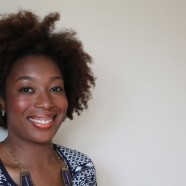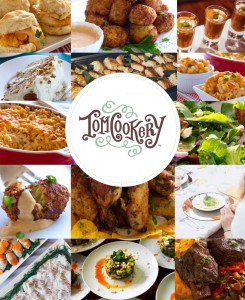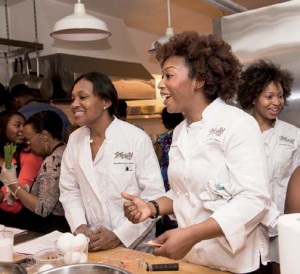
Tomica “Tom” Burke ’01 could check all the boxes on any “path to success” template: boarding school, excellent college, Capitol Hill job, prestigious law school, a position at a Manhattan law firm. But after two years, she left her law firm, and one year later she launched TomCookery, a catering company featuring Caribbean and Southern-inspired food, based in Queens, New York.
“It all started at Milton,” says Tom. “For my senior project, I wrote a cookbook. This was before food was sexy, but I felt this urgency about wanting to preserve our family recipes.” For the project, Tom started with her grandmothers. One lived in Queens, where Tom grew up; she spent a week there, transcribing the “how to” of many of her family’s signature dishes. She then traveled to Barbados — where she lived as a young child — to cook with and learn from her other grandmother. Back at Milton, she brought the recipes to life in the Robbins House kitchen and compiled the cookbook. A “Top Chef-style dinner” for Robbins House faculty culminated her project.
“It was the only unstructured time in my whole life, and what I chose to do was — food. I spent only five weeks on the project, and I didn’t come back to it until I left my job. Food never felt like a serious career choice, or a career choice at all. I didn’t have any shame about it, but people told me, ‘No, you are going to take over the world; you are going to be a lawyer or a doctor.’ But I found myself increasingly dissatisfied with my career.”
 Tom started dabbling in food again during her third year at Columbia Law School. She had secured a job in her field. At the time, many firms were offering large cash incentives to law school graduates who agreed to one-year deferments. Tom was the only one praying for a deferment, but the job offer stood.
Tom started dabbling in food again during her third year at Columbia Law School. She had secured a job in her field. At the time, many firms were offering large cash incentives to law school graduates who agreed to one-year deferments. Tom was the only one praying for a deferment, but the job offer stood.
“I thought that with a year off, I could cater or go to culinary school. I took cooking classes anyway, and I moonlighted with a caterer. I started cooking for my friends, entertaining and throwing parties. One friend asked me to do his New Year’s Eve party for 60 people. I didn’t start cooking until six hours before the party. It was an ambitious menu, but it was a hit. I thought, ‘People are raving about this food. I can do this for a living!’”
After leaving the firm in 2012, Tom worked for eight months on the Democratic Convention with a former Capitol Hill boss. She used that time to plan her business. Although she never wrote a formal business plan, she educated herself by researching online: How much are staff members paid? How much does it cost to rent a kitchen? How much does storage cost? How much food do I need? She funded the whole endeavor with her savings. The first year was a “learn as you go” experience. Today, TomCookery runs out of a shared kitchen with part-time staff and stages events all over New York City. Tom’s family was more than in favor of her career change: “My old job bored my family to tears; they think what I’m doing now is fun.”
Scaling up her recipes to cook for large groups of hungry people doesn’t faze Tom. Each event breaks down into three stages of work: a planning day, a cook day, and an event day. She starts with two crucial pieces of information from her clients: how many people, and what do they want to eat?
“Once I see that we have a 50-person party and they want two entrees, two sides, a dessert and a salad, it’s pen to paper. How many pounds of short ribs will I need for 50 people? We batch out our recipes. So we need 30 pounds of bone-in short ribs or 20 pounds of boneless short ribs. You do that with every single recipe and every single ingredient.” She develops the budget, figures out all the counts, and compiles shopping lists.
 Nailing down the pricing component of running a catering company took her some time. “Standard catering practice is to multiply your actual cost by three, and charge that. Sometimes that feels like an outrageous price, and sometimes it’s not enough. Labor is the most expensive part of my operation. Other caterers might use pre-made food, like frozen hors d’oeuvres. I don’t. I make almost everything from scratch. We make these little macaroni and cheeses that I’m literally spooning into mini-muffin pans. This takes time, but they taste so much better. We make dishes the way your grandmother made them. The challenge is figuring out what you value and charging a price that reflects that. I can’t worry about losing customers. People who value our work will pay for the product.”
Nailing down the pricing component of running a catering company took her some time. “Standard catering practice is to multiply your actual cost by three, and charge that. Sometimes that feels like an outrageous price, and sometimes it’s not enough. Labor is the most expensive part of my operation. Other caterers might use pre-made food, like frozen hors d’oeuvres. I don’t. I make almost everything from scratch. We make these little macaroni and cheeses that I’m literally spooning into mini-muffin pans. This takes time, but they taste so much better. We make dishes the way your grandmother made them. The challenge is figuring out what you value and charging a price that reflects that. I can’t worry about losing customers. People who value our work will pay for the product.”
One thing that surprised Tom was how much time it took to feel like an established business. Factors she hadn’t anticipated arose: seasonal business slumps, the isolation of not going to a workplace every day, the challenge of managing people.
“To grow your business, you have to put yourself in uncomfortable situations,” she says. “Before starting a business, I was against things like networking or approaching people out of the blue. When you own a business, though, you have to embrace both. Every time I do, my business grows in unexpected ways. Being shy and self-conscious doesn’t work. That has to go out the window when you’re working for yourself and promoting your brand. I didn’t realize I had it in me, until I did it.”
An unidentified call from a Los Angeles phone exchange turned up an unexpected opportunity for Tom. Food Network was on the line, asking her to compete on “Cutthroat Kitchen.” At a minimum, Tom thought, this would give the business exposure, and if she won, what could be better? She decided not to “hide behind her chef jacket,” and she won the competition.
“That show boosted my confidence. I never expected to win — I just didn’t want to go out in the first round! I would do more TV, but it’s hard to run a business and do anything extra. The events come first.”
Tom’s philosophy is that food should deliver on flavor and evoke memories. Serving food you love, she believes, is about sharing, family and togetherness.
“I follow some chefs on Instagram, and sometimes I feel inadequate because I’m not making a lobster pomegranate gelée, but I don’t want to eat that, so why would I cook it? Flavors are my strong point. I like having unexpected sweetness in a dish. Spices, like cinnamon, are connected to emotion and take people back. I love braised meals, like meat falling off the bone — anything that feels like home.”
Tom also likes to play with food, serving familiar flavors in an unexpected way. For a Barbados tourism reception, she adapted the country’s beloved, national dish, “Cou Cou and Flying Fish,” to serve it as a unique appetizer. It was a hit.
Tom’s business is growing and evolving into a one-stop shop for people planning events. She provides mixology services and party planning, and she transforms spaces into unique sensory experiences. She recently transitioned some of her kitchen operation to free up time for strategizing and rebranding. She is at the precipice that many small businesses face: looking for investors, and figuring out which risks make sense.
“I was an English major at University of Virginia, and I was very bookish. But just because you’re smart and capable doesn’t mean you are destined for certain careers. We need smart, capable people in every field. Since I started doing what I love, I’m much happier.”
by Liz Matson



